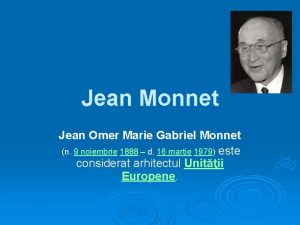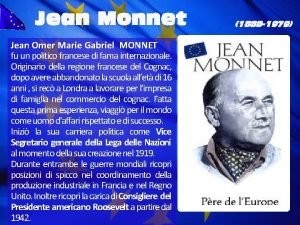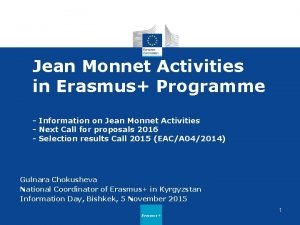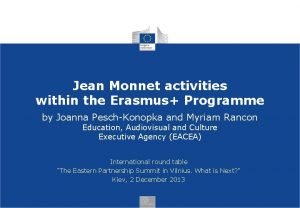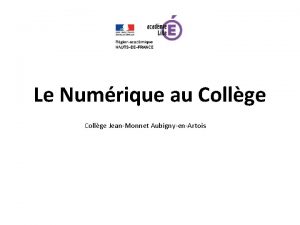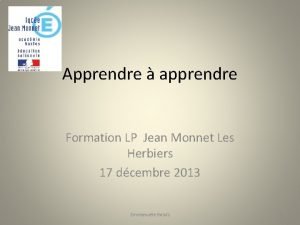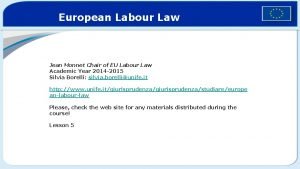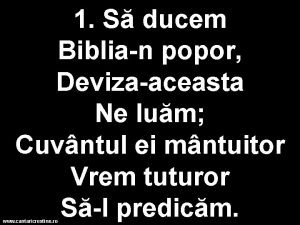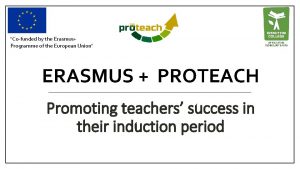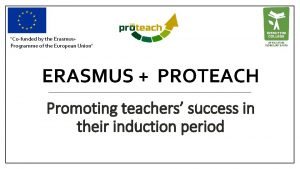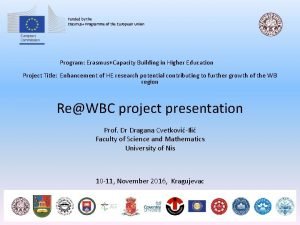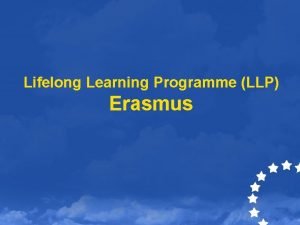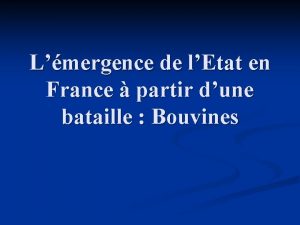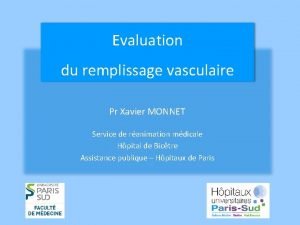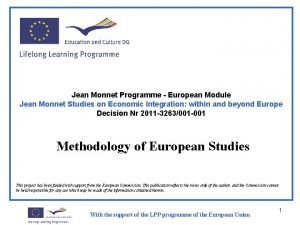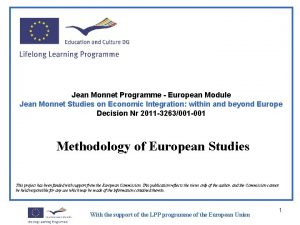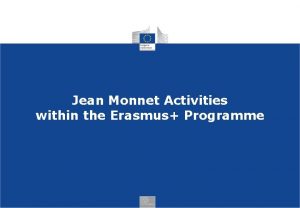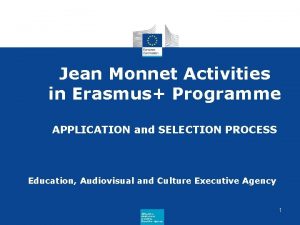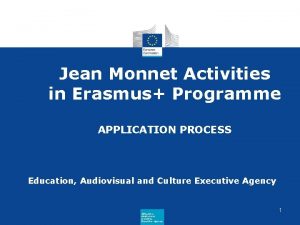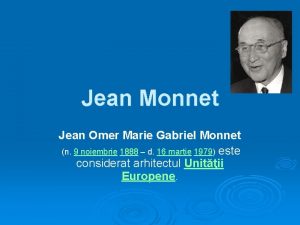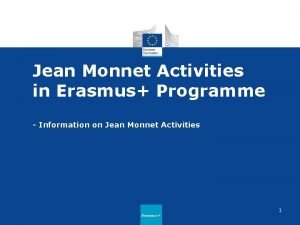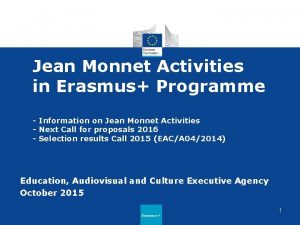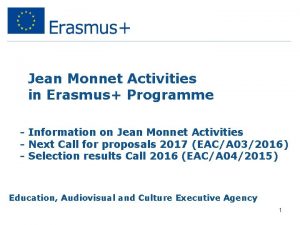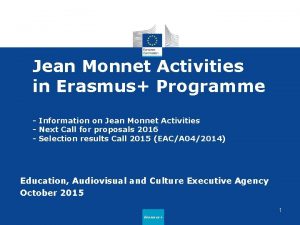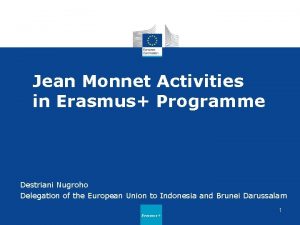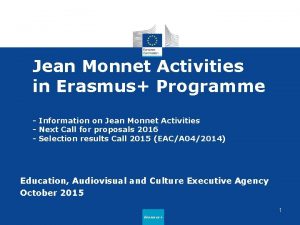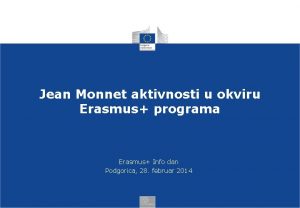Jean Monnet Activities in Erasmus Programme APPLICATION and




















- Slides: 20

Jean Monnet Activities in Erasmus+ Programme APPLICATION and SELECTION PROCESS Education, Audiovisual and Culture Executive Agency Education, Audiovisual & Culture Executive Agency 1

Before starting the application Detailed consultation of the reference documents 1. Call for Proposals 2. Erasmus+ Programme Guide, e-tutorials, FAQ, Information on PI funds

Before starting the application Applicants must have an ECAS (European Commission Authentication Service) account. https: //www. cc. cec/cas/login http: //www. cc. cec/itservices/en/co ntent/ecas-european-commissionauthentication-service

Participant Identification Code (PIC) – specific issues Participant Identification Code (PIC) The applicant organisation (and for the Jean Monnet Networks – also the partner institutions involved) must be registered in the Participant Portal and receive a Participant Identification Code (PIC). http: //ec. europa. eu/education/participants/port al/desktop/en/organisations/register. html

Participant Identification Code (PIC) – specific issues The applicants are required to use the same PIC for all their applications for EU funding The applicants should make sure that the PIC profile is complete

Application process • Instructions for completing the application package and • an e. Form User Guide are published on the EACEA website.

Application process The application package is composed of the e. Form and three compulsory annexes: 1. Detailed Project Description 2. Budget Form 3. Declaration of Honour - Fill in the e. Form, and complete and attach the compulsory annexes. - Validate the e. Form. - Automatic check: If form is complete it can be submitted online. - Successful submission confirmation email and reference number. NB: No paper copy is required

1) Complete the e. Form Part A. Applicant organisation (and partners for Networks only) à Most details automatically retrieved from the Participant Portal à ECHE to be verified Part B. Major information about the project: summary, priorities and topics addressed, duration, budget Part C. Specific information: discipline, number of teaching hours, students, etc.

Annex I Description of the project Part D. Characteristics and relevance: Rationale for the proposal, relevance to the objectives of the Action, relevance to target groups Part E. Participating organisations – teams: Aims and activities of the organisation, skills and expertise of key staff (publications, teaching) Part F. Design and implementation of the proposal: Work programme, methodology, time schedule Part G. Impact, dissemination and exploitation Part H. Curriculum Vitae and full list of publications

Annex II Budget table 3 forms depending on the Action type: Modules & Chairs - Flat-rate financing: Indicate number of teaching hours planned Top-up percentage added for complementary activities Total budget and EU grant calculated automatically Projects - Flat-rate financing: Indicate number of events, participants and speakers Top-up percentage added for complementary activities Total budget and EU grant calculated automatically Centres of Excellence, Associations, Networks – Budget-based financing: Indicate all expenses planned by costs categories (staff, travel and subsistence, subcontracting, equipment, other costs, indirect costs)

Annex III Declaration of Honour To be signed by the legal representative To include the name of the action To indicate the exact amount of the grant requested in EURO

What happens once the application is submitted?

Award criteria 1. Relevance of the project OBJECTIVES PRIORITIES AND ADDED VALUE TARGET GROUPS

Award criteria 2. Quality of the project design QUALITY OF WORK PROGRAMME CONSISTENCE BETWEEN OBJECTIVES AND ACTIVITIES ADN BUDGET FEASIBILITY

Award criteria 3. Quality of the project TEAM PERTINENCE OF PROFILE RELEVANT EXPERIENCE

Award criteria 4. IMPACT AND DISSEMINATION IMPACT DISSEMINATION

Coherence and feasibility Priorities and objectives Activities Impact

What happens once the application is submitted? Selection Process • The best proposals are selected for funding • All candidates are informed, and results are published • Grant Agreements/Decisions are prepared for successful proposals • Start of the projects 1 September of the year of application 18

Application and Selection procedure Indicative roadmap for selection process Steps Date Publication Erasmus+ Jean Monnet Call for proposals 20 October 2016 Deadline for submission of applications 23 February 2017 at 12: 00 Verification of eligibility of project proposals February – March 2017 Evaluation Committee for selection of projects July 2017 Award decision by Agency AO July 2017 Notification of applicants and publication of results July 2017 Preparation of Grand Agreements/Decisions August – September 2017 Start of projects 1 September 2017

More information – Jean Monnet • Erasmus+ Programme Guide and 2017 General Call for proposals: http: //ec. europa. eu/programmes/erasmus-plus/discover/guide/index_en. htm • Jean Monnet Activities: http: //eacea. ec. europa. eu/erasmus-plus/actions/jean-monnet_en • Funding - Jean Monnet Activities within Erasmus+: http: //eacea. ec. europa. eu/erasmus-plus/funding_en • Jean Monnet Directory: https: //eacea. ec. europa. eu/Jean. Monnet. Directory/#/search-screen/ • Jean Monnet selection results: http: //eacea. ec. europa. eu/erasmus-plus/selection-results_en • Jean Monnet Cluster 2016: Good practices in the context of 'A Union of shared values – The role of Education & Civil Society' http: //eacea. ec. europa. eu/erasmus-plus/library_en • Erasmus+ Project Results – Jean Monnet: Erasmus+ platform for dissemination and exploitation of project results http: //ec. europa. eu/programmes/erasmus-plus/projects/ • Mailbox Jean Monnet: EACEA-AJM@ec. europa. eu 20 Erasmus+
 Jean omer marie gabriel monnet
Jean omer marie gabriel monnet Jean monnet jean-gabriel monnet
Jean monnet jean-gabriel monnet Jean monnet activities
Jean monnet activities Jean monnet activities
Jean monnet activities Jean monnet activities
Jean monnet activities Ent aubigny en artois college jean monnet
Ent aubigny en artois college jean monnet Jean monnet les herbiers
Jean monnet les herbiers Jean monnet chair
Jean monnet chair Jean monnet chair
Jean monnet chair Lum jean monnet
Lum jean monnet Co-funded by the erasmus+ programme of the european union
Co-funded by the erasmus+ programme of the european union Co-funded by the erasmus+ programme of the european union
Co-funded by the erasmus+ programme of the european union Co-funded by the erasmus+ programme of the european union
Co-funded by the erasmus+ programme of the european union Llp erasmus
Llp erasmus Both indoor and outdoor sports
Both indoor and outdoor sports Primary and support activities
Primary and support activities Primary activities and secondary activities
Primary activities and secondary activities Pascale monnet chaloin
Pascale monnet chaloin Xavier monnet
Xavier monnet Erasmus uwe
Erasmus uwe Operating activities vs investing activities
Operating activities vs investing activities
